Unraveling July's Gem: The Ruby's Rich Legacy
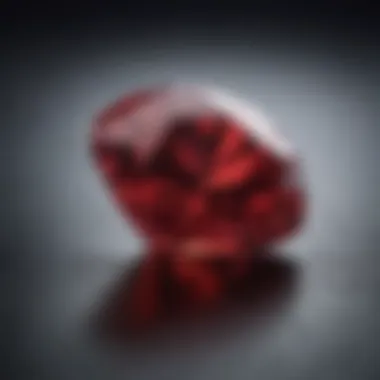
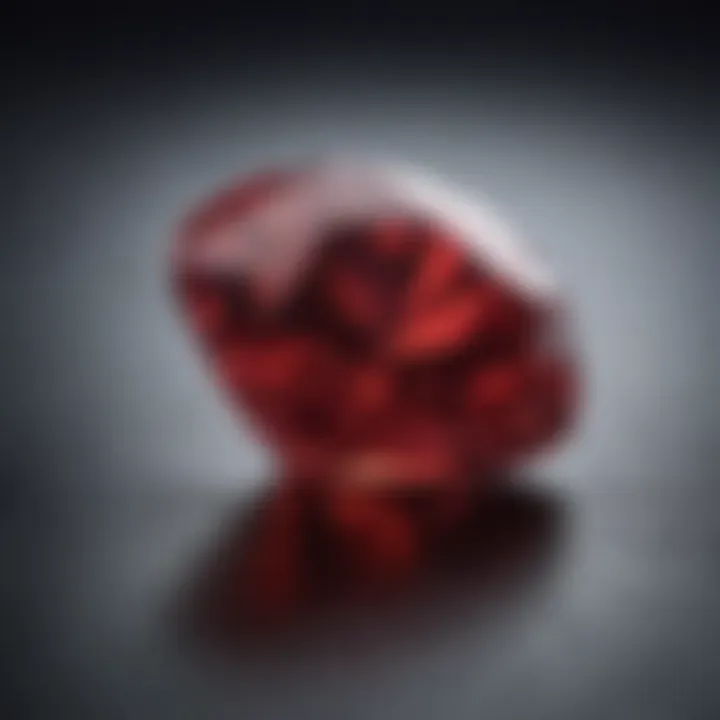
Intro
July is an intriguing month, not only due to its warm and vibrant summer days but also because it is home to one of the most celebrated gemstones: the ruby. Renowned for its striking red hue and rich symbolism, rubies are cherished by both collectors and jewelry enthusiasts. In this guide, we will explore the various dimensions of July's birthstones, focusing on rubies in depth. From their definition and characteristics to their historical significance and care tips, this comprehensive resource aims to cater to individuals at all levels of interest.
Gemstone Overview
Definition and Characteristics
Rubies are a type of corundum, a mineral that is primarily composed of aluminum oxide. Their red color is a result of the presence of chromium within the gemstone, making them unique compared to other varieties of corundum, such as sapphires. The most valued rubies exhibit a rich, vivid red, often referred to as "pigeon blood." This color is highly desirable and can greatly affect the stone's market value.
Rubies score a 9 on the Mohs scale of hardness, ensuring durability and making them suitable for everyday wear in jewelry. Additionally, rubies can have unique inclusions, known as "silk," that create an appealing appearance and enhance their charm. Their brilliance and luster are undeniable, contributing to their prestigious reputation.
Classification of Gemstones
Gemstones can be classified based on various criteria, including mineral composition, hardness, and value. Rubies fall under the category of precious gemstones, alongside diamonds, emeralds, and sapphires. The distinction here arises from both their rarity and their perceived aesthetic value.
On a broader scale, gemstones can be divided into two categories: natural and synthetic. While natural rubies are mined from the earth, synthetic rubies are created in laboratories. The latter can exhibit similar physical and optical properties but typically lack the historical significance associated with natural stones.
Historical Significance
Ancient Uses and Cultural Importance
Rubies have a longstanding history, often associated with wealth, power, and passion. Ancient civilizations held these gemstones in high esteem. In India, for example, rubies were often embedded in armor, believed to protect the wearer from harm. The ancients viewed rubies as symbols of life and energy, further solidifying their esteemed status across cultures.
Throughout history, rubies have been adorned by royalty and donned in exquisite jewelry pieces. They were even mentioned in biblical texts, signifying their deep-rooted connection with spirituality and morality.
Myths and Legends Surrounding Gemstones
Rubies are surrounded by numerous myths and legends. One prominent belief is that rubies bring good fortune and attract love and passion. Some cultures even argued that wearing a ruby would enable one to foresee danger and improve one’s health. These stories illustrate the gemstone's multifaceted appeal, showcasing its significance beyond mere aesthetics.
In essence, the allure of the ruby extends far into the past, intertwining with various cultural narratives and beliefs. With such a rich history, it is no wonder that rubies continue to captivate enthusiasts across the globe.
Intro to July Birthstones
The birthstones of July hold a significant place in both culture and tradition. Among them, rubies stand out due to their vibrant red hue and rich history. This section will highlight the importance of July birthstones by examining their significance, the allure of rubies, and their benefits for those born in this month. Such gemstones are often more than decorative; they symbolize personality traits, birth months, and sometimes a connection to power or love.
The Significance of Birthstones
Birthstones have long been associated with various beliefs and traditions. They are seen as not only a way to celebrate one's birth month but also as a conveyer of good fortune. Each stone is thought to bring specific qualities and benefits to the individual. For July, the ruby is believed to promote vitality, energy, and passion. These stones can also embody the hopes and dreams of the wearer, adding a layer of personal significance to their aesthetic appeal.
Furthermore, wearing one's birthstone is thought to enhance one’s personal strengths and provide protective qualities. This could be why many people choose to incorporate their birthstone into daily jewelry wear or special gifts. Even today, individuals often gift rubies to mark significant occasions, making the stone a timeless symbol of love and commitment.
Overview of Ruby as the July Birthstone
Ruby, the classic July birthstone, is renowned for its deep red color, a result of chromium within the corundum mineral. Its value is often determined by color, size, and clarity. The clearer and more vivid the color, the higher the value of the ruby.
Historically, rubies have been cherished among royalty and have adorned crowns and jewelry throughout the ages. This gemstone was often seen as a stone of protection, believed to guard wearers against misfortunes and bad dreams. Such beliefs add to the intrigue and allure surrounding rubies.
In modern times, the ruby’s appeal continues. Many jewelry designers use it in various settings, making it a popular choice for rings, necklaces, and earrings. Its cultural and historical significance deepen the appreciation many have for rubies, encouraging collectors and enthusiasts to seek high-quality specimens.
"Rubies symbolize love and passion, linking the gemstone to deep emotional connections for individuals born in July."
In summary, understanding July birthstones, particularly rubies, enhances one's appreciation for their beauty and significance. They are more than mere stones; they represent identity, history, and personal stories.
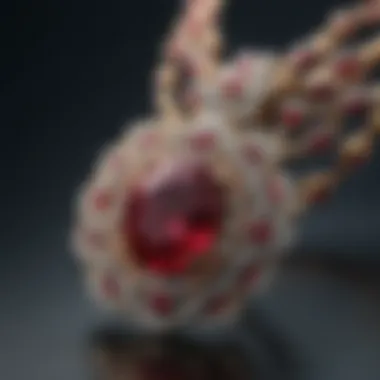

The Ruby: A Brief History
Understanding the history of rubies enriches appreciation for this remarkable gem. By learning about their past, one gains insight into their value beyond mere aesthetics. Rubies possess a unique combination of beauty and historical significance that makes them one of the most coveted gemstones. The journey of rubies through time reveals much about the cultures that cherished them.
Historical Importance of Rubies
Rubies have held a prominent position in various societies for centuries. Historically, these gems were often regarded as symbols of power and prestige. In ancient times, they were believed to protect the wearer in battle. Many warriors wore rubies as a talisman, believing these stones would grant bravery and strength.
In Asia, rubies were celebrated as a significant jewel. The Burmese hailed them as the "blood of the heart," attributing mythical qualities to their vivid red hue. Ancient texts describe them as offering protection against evil spirits. During the 16th century, rubies appeared in royal crowns and adornments, showcasing their esteemed status among nobility.
The exceptional hardness of rubies makes them suitable for daily wear, thus enhancing their allure in jewelry. In the 19th century, the discovery of more ruby deposits notably in Myanmar fueled their popularity. The availability made rubies even more desirable; they became sought after not just by royalty but by a wider audience as well.
Cultural Symbolism of Rubies Across Civilizations
Cultural interpretations of rubies vary significantly across different civilizations.
- In Hindu culture: Rubies symbolize love and passion. They are often associated with the sun, signifying vitality and energy.
- In ancient Chinese tradition: The stone represented power. Rubies were often gifted to emperors, encapsulating wealth and status.
- The ancient Romans: Considered rubies as a connection to the gods. They believed that these gemstones could help them achieve their desires.
Rubies also hold a special place in mythology. They are often referenced in stories and myths that speak of their magical properties. The rich symbolism has ensured that centuries later, rubies continue to captivate imaginations.
"Rubies are more than just beautiful stones. They carry stories of strength, love, and cultural significance that transcend borders and generations."
In recent times, the enthusiasm for rubies persists among jewelers and collectors alike. Each gem, with its burst of color, carries echoes of the past that enhance its charm. Understanding the cultural contexts of rubies adds depth to their significance, transforming them from simple adornments into cherished artifacts of human history.
Physical Characteristics of Rubies
Understanding the physical characteristics of rubies is essential for gem enthusiasts and collectors. These attributes not only help identify the quality of the gemstone but also influence its value in the market. Rubies, known for their rich red hue, offer a range of qualities that dictate their desirability. Knowing these characteristics enables buyers to make informed decisions and appreciate the uniqueness of each piece.
Chemical Composition and Formation
Rubies are a variety of corundum, comprised primarily of aluminum oxide. The intense red color comes from trace amounts of chromium. This chemical element not only gives rubies their vibrant hue but also enhances their overall appeal. The geological formation of rubies is a complex process, requiring immense pressure and heat deep within the Earth’s crust. As a result, high-quality rubies are often formed over millions of years, making them sought after in both the jewelry market and for collectors. Understanding these origins can deepen one's appreciation for the gem's rarity.
Identifying Quality: Color, Clarity, and Cut
Several factors help determine the quality of a ruby, with color being the most crucial. The best rubies exhibit a pure red color, often referred to as "pigeon blood" red. Clarity is also significant; while inclusions are common, fewer visible imperfections can significantly boost a ruby's value. The cut refers to how well the ruby has been shaped and polished. An excellent cut enhances light reflection, showcasing the gem's vivid color. When examining rubies, attention to these details is critical for collectors and buyers alike.
Hardness and Durability of Rubies
Rubies rank 9 on the Mohs scale of mineral hardness, making them one of the most durable gemstones available. This hardness allows rubies to resist scratches and daily wear, making them suitable for various types of jewelry, including rings and bracelets. Their durability is an essential consideration for wearers who want pieces that can endure everyday use without easily showing signs of damage or wear. Caring for rubies properly can preserve their beauty for generations, adding to their appeal as heirloom pieces.
"The combination of chemical composition, color quality, and durability makes rubies not only beautiful but also practical investments for those who appreciate fine gemstones."
Metaphysical Properties of Rubies
Rubies possess a rich tapestry of metaphysical properties that appeal to those interested in both spiritual growth and emotional well-being. Understanding these properties not only enhances the appreciation of rubies as gemstones but also offers insight into their potential benefits. For gemstone enthusiasts, these aspects are critical when considering the purchase or use of rubies in various practices.
Healing Properties and Spiritual Significance
Rubies are often associated with vitality and energy. They are believed to enhance life force and promote passion. Many practitioners in alternative healing circles assert that rubies have the power to stimulate the heart and root chakras. By energizing these centers, rubies can help foster love, courage, and self-awareness.
- Emotional Healing: People often turn to rubies for emotional healing. The stone encourages positive dreams and helps to dissolve negative energy.
- Physical Well-Being: Rubies are also thought to aid in physical health. They are linked to improved circulation and vitality, allowing individuals to feel recharged.
- Enhances Motivation: Those who feel stagnant often use rubies to boost motivation, encouraging action toward goals and aspirations.
The significance of rubies extends to various cultures, where they are revered not just for their beauty but also for their alleged ability to instill confidence and strength in those who wear them.
Rubies in Meditation and Manifestation Practices
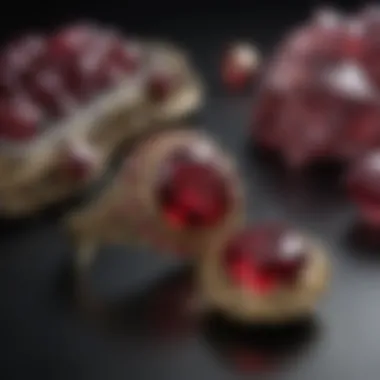
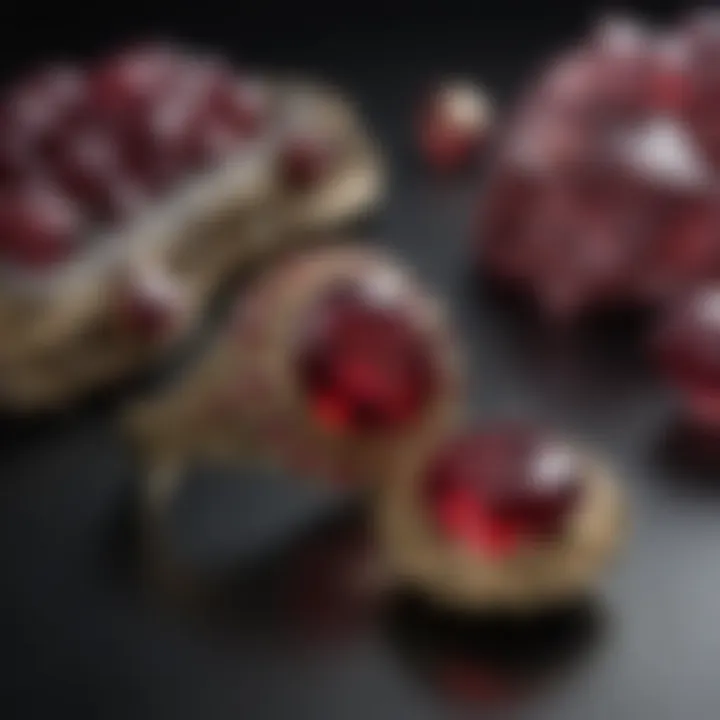
In meditation and manifestation, rubies serve as a focus tool. They are believed to bring intentions to life and enhance visualization practices. Their vibrant energy helps elevate the spiritual experience and maintain clarity during performance.
When incorporating rubies into meditation:
- Choose a quiet space and hold the ruby in your hand or place it on your heart.
- Focus on your intentions and visualize them manifesting.
- Allow the ruby's energy to harmonize with your own, facilitating a deeper connection to your goal.
Many meditation experts suggest using rubies during moon phases, believing their energy resonates with intentions set at these times. Their presence can be an effective way to harmonize one’s life-force energy with the universe’s abundance.
In summary, the metaphysical properties of rubies extend beyond mere beliefs; they offer potential avenues for personal growth and emotional healing. For collectors or anyone keen on gemstones, understanding these elements can enhance the overall experience and appreciation of rubies.
Caring for Rubies
Caring for rubies is a critical aspect of owning and appreciating these gemstones. Rubies are prized not just for their vibrant color but also for their durability. However, proper care ensures they maintain their beauty and integrity over time. Understanding the best practices for cleaning and storing rubies can save enthusiasts from potential damage and help in maximizing their investment. Here, we delve into effective techniques to maintain your ruby's quality, yet, such great beauty requires your attention.
Proper Cleaning Techniques for Rubies
Keeping rubies clean is fundamental for preserving their brilliance and luster. Improper cleaning, on the other hand, can lead to scratches and dullness. Here are some recommended techniques:
- Soft Cloth Cleaning: Use a soft, lint-free cloth to wipe the surface of the ruby. This technique removes surface dust and oils without scratching the stone.
- Mild Soapy Water: For deeper cleaning, prepare a solution of warm water and a few drops of mild dish soap. Soak the ruby for a few minutes, then gently brush with a soft toothbrush, particularly in settings or intricate designs to avoid residues.
- Avoid Harsh Chemicals: Never use bleach or abrasive cleaners. These can damage the ruby's surface and degrade any settings it might be in.
It is recommended to clean rubies regularly, especially if they are worn frequently. Regular maintenance prevents dirt buildup that can dull their sparkle.
Storage Practices to Preserve Ruby Quality
Once cleaned, proper storage is essential for protecting your rubies from damage. Here are effective practices to keep in mind:
- Separate Storage: Store each ruby separately. Using a fabric-lined box or a dedicated jewelry case can prevent scratches caused by contact with other gemstones.
- Avoid Exposure to Direct Sunlight: Prolonged exposure can lead to color fading over time. Create an environment that is cool and dark for storage.
- Use Anti-Tarnish Pouches: If you need to store rubies with metal settings, consider using anti-tarnish pouches or cloths to prevent oxidation.
"Protecting your ruby from scratches and damage is as important as its beauty. Nestling your precious gem in a safe environment helps maintain its radiant allure."
By following these practices, rubies can remain in excellent condition, allowing their owners to enjoy the splendor of this July birthstone. Proper care not only enhances the aesthetic appeal of rubies but also contributes significantly to their longevity, making any engagement with these gems a worthwhile experience.
Current Market Trends for Rubies
Understanding the current market trends for rubies is essential for anyone involved in the gemstone sector. This section elaborates on two major aspects of the ruby market: the dynamics of demand and supply, and the investment potential of rubies. These elements are intertwined, influencing the market's overall health and the choices made by collectors and investors alike.
Demand and Supply Dynamics in Ruby Markets
The demand for rubies has seen a noteworthy resurgence in various segments. Several factors drive this trend, including increased visibility in high-fashion jewelry and luxury markets. As consumers seek unique and striking pieces, the allure of natural rubies continues to captivate. Moreover, the rise of online retail platforms has broadened the market reach, allowing buyers to access a wider range of rubies than previously possible.
On the supply side, the availability of quality rubies can drastically impact prices. Major sources include Myanmar, also known as Burma, and Thailand. However, rubies from these countries are often supplemented by stones from Africa and Asia, which has changed the landscape of ruby sourcing.
- High-Quality Rubies: The most desirable rubies are those with intense color saturation and exceptional clarity. The rarity of such stones adds to their desirability.
- Synthetic Rubies: The production of synthetic rubies poses a challenge as they are widely available at a lower price point. Understanding natural versus synthetic stones is crucial for collectors and investors.
Both elements of the demand and supply dynamics influence consumer perception and market prices in the long run. Buyers should be informed about these trends to make better purchasing decisions.
Investment Potential of Rubies
Rubies are increasingly recognized as valuable investment options. This trend stems from several favorable factors that position rubies uniquely compared to other gemstones. An essential part of their appeal lies in their historical value and cultural significance, which often enhances their desirability.
- Performance in Investment Markets: In recent years, rubies have shown remarkable resilience against market fluctuations. Their durability and scarcity can offer a hedge against inflation, making them attractive for long-term investment.
- Rarity vs. Demand: The balance between the rarity of high-quality rubies and their increasing demand creates a compelling case for investment. Prices are expected to escalate as the availability of quality rubies diminishes.
- Collectors Market: A growing number of serious gemstone collectors are incorporating rubies into their portfolios. High-quality pieces from reputable sources can command significant prices at auctions, which further illustrates their investment potential.
"The unique characteristics of rubies as both a gemstone and an investment vehicle make them a compelling choice for discerning collectors and investors."
In summary, staying informed about current market trends for rubies enables enthusiasts and investors alike to navigate the complexities of the ruby market effectively. Understanding demand, supply dynamics, and the investment potential of rubies not only enhances appreciation for these gemstones but also aids in making informed decisions.
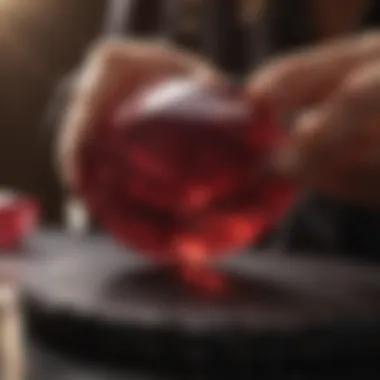
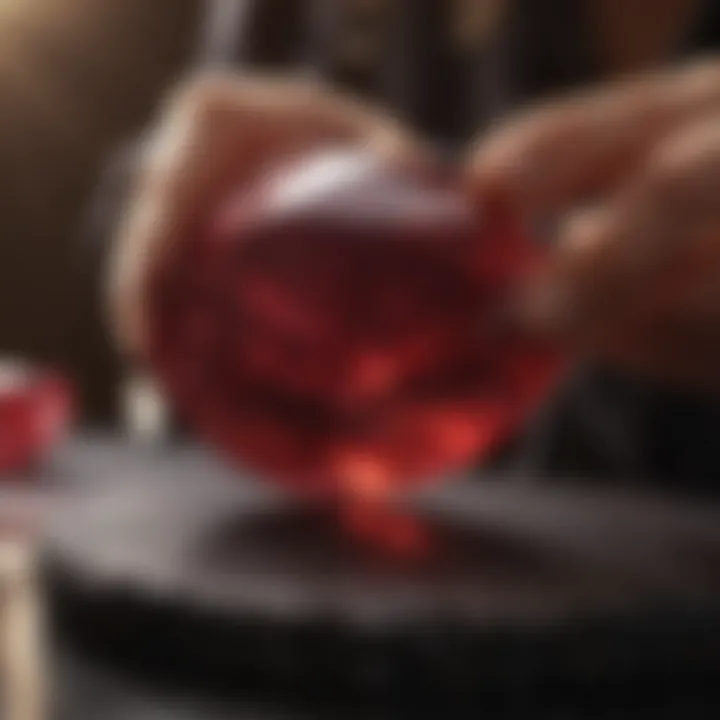
Rubies in Jewelry
Rubies hold a significant place in the world of jewelry. Their vibrant red color and exceptional durability make them highly sought after. In this section, the focus will be on the importance of rubies in jewelry design and how they enhance personal adornment.
Rubies are often associated with passion and power. This perception elevates their status not only as decorative objects but also as symbols of strength and vitality. Jewelers often select rubies for pieces intended to symbolize love and commitment, such as engagement rings and anniversary gifts. Their durability, rated at 9 on the Mohs scale, ensures they can withstand daily wear, adding to their appeal for both designers and consumers.
Popular Jewelry Designs Featuring Rubies
Several jewelry designs prominently feature rubies, reflecting their timeless charm. Some of these popular styles include:
- Engagement and Wedding Rings: Rubies serve as stunning alternatives to traditional diamonds, offering a unique touch to engagement rings. Many people appreciate their symbolism of love and loyalty.
- Earrings: Ruby stud earrings or dangling designs illuminate any outfit, making them versatile for both casual and formal settings.
- Necklaces: Ruby pendants and statement necklaces can create a focal point in an ensemble. Their rich hue can enhance various styles.
- Bracelets: From simple bangles to intricate designs with multiple stones, rubies add a splash of color and a hint of luxury.
Each design can be customized, combining rubies with other gemstones or metals, allowing for personal expression.
Choosing the Right Ruby Jewelry for Various Occasions
When selecting ruby jewelry, understanding the context and the occasion is essential. Different settings call for varied styles of ruby jewelry:
- Formal Events: For black-tie events, opt for elegant ruby pieces, such as drop earrings or a classic ruby necklace. These designs complement evening wear well.
- Everyday Wear: For day-to-day use, simpler ruby jewelry, like stud earrings or a modest pendant, can be both stylish and practical.
- Gifts: When purchasing ruby jewelry as a gift, consider the recipient's personal style and wardrobe. A timeless piece, such as a ruby ring, can be cherished for years.
- Symbolic Occasions: Rubies are often given to celebrate milestones such as anniversaries or birthdays. Their deep red hue symbolizes deep affection and commitment, making them perfect for these events.
Ethical Considerations in Ruby Sourcing
The topic of ethical sourcing is vital in the context of precious stones, particularly rubies. As the demand for rubies increases, so does the necessity to ensure that their procurement does not harm individuals or communities. Awareness of the ethical aspects of ruby sourcing impacts both consumer choices and industry standards. By understanding these considerations, we can support responsible practices that uphold human rights and environmental sustainability.
Understanding the Ruby Supply Chain
The supply chain of rubies is complex, involving multiple stages from mining to retail. Rubies are often mined in developing countries, where conditions can be dire. Workers may face hazardous environments, low wages, and exploitation. The lack of regulation in these regions exacerbates these issues.
- Mining Locations: Major ruby mines are located in Myanmar, Thailand, and Africa. Each country presents unique challenges and regulations concerning mining.
- Processing and Trading: After extraction, rubies are processed and traded, often changing hands several times before reaching consumers. This convoluted process can obscure the origins of the gemstones.
- Certification: Realistically, verifying the ethical sourcing of rubies is challenging. Some organizations offer certification to ensure that rubies have been responsibly mined, but not all suppliers adhere to these practices.
"Understanding the supply chain helps consumers make informed decisions when purchasing rubies, reflecting their values and beliefs in their choices."
Supporting Ethical Ruby Mining Practices
Supporting ethical practices in ruby mining benefits both the communities involved and the consumers. Here are some key aspects to consider:
- Fair Trade Practices: Consumers should seek out retailers who prioritize fair trade rubies. This means buying from sources that ensure fair wages and safe working conditions for miners.
- Sustainable Mining: Sustainable mining practices play a crucial role, aiming to minimize environmental impact. Encouraging mines that use eco-friendly methods preserves the habitats surrounding mining areas.
- Transparency in Sourcing: Retailers can contribute by being transparent about the origin of their rubies. Providing detailed information helps build trust and aligns consumer values with purchasing choices.
The End
The conclusion serves as a vital component of this comprehensive guide as it summarizes key takeaways concerning July birthstones, particularly rubies. It aids readers in consolidating their understanding of the various aspects discussed in the article, from the historical significance and physical properties of rubies to their cultural implications and market trends.
In reflecting on the insights presented, enthusiasts and collectors can appreciate the multifaceted nature of rubies. It reinforces their value not just as adornments but as pieces of art steeped in rich history. Additionally, it emphasizes the importance of ethical sourcing, binding the beauty of rubies to responsible practices within the industry. Readers should take note of caring techniques, ensuring the longevity of these gems.
This section also invites consideration for future discussions in gemstone studies. As the sapphire and other birthstones come under scrutiny, comparisons can illuminate further aspects of rubies and their role in the world of gems. Furthermore, recognizing emerging trends could influence purchasing decisions, driving interest toward responsible investment in the ruby market.
"Understanding the significance of rubies extends beyond aesthetics; it's about appreciating their historical depth and ethical implications."
Recap of July Birthstone Insights
The insights into July birthstones cover a broad spectrum. The ruby, celebrated as July's primary gemstone, holds an esteemed position in various cultures. It has embodied love, passion, and power throughout history. Rubies often serve as a symbol of vitality and energy, contributing to their enduring popularity.
Quality identification based on color, clarity, and cut is fundamental for both buyers and collectors. There is considerable importance in recognizing that not all rubies are the same; variations in these factors result in different valuations. Ethical sourcing practices call attention to the influence of responsible actions within the ruby supply chain, heightening awareness for conscientious consumers.
Future Trends and Research in Gemstone Studies
Looking forward, the realm of gemstone studies continues to evolve. Advancements in technology and research methodologies promise to unveil new findings about rubies and other gemstones. Ongoing studies into the geological formations of these gems may enhance understanding of their characteristics and variations.
Emerging market trends indicate a growing preference for ethical gemstones. As the demand for transparency in sourcing increases, it is likely that more consumers will seek out information regarding the origins of rubies. This trend could significantly impact ruby pricing and availability as consumer behavior aligns with sustainable practices.
Moreover, the role of gemstones in well-being and metaphysical practices remains a fascinating area for research. Further exploration could illuminate intrinsic connections between gems and their cultural significance, influencing jewelry design trends moving forward.







